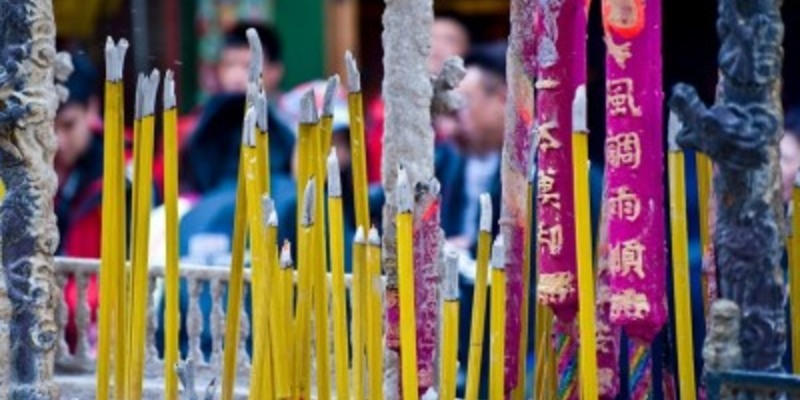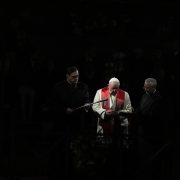The conference on religions on November 26, chaired by Deputy Prime Minister Wang Yang, and the new regulations on the Religious organization which came into effect on February 1st are the latest step, in chronological order, in a long march by China to deal with religions as they are conceived in the West and to try to adapt them to the new Chinese state.[1]
In many cases, religious groups, including parts of the Catholic Church see these actions as directly aimed at them – to fight the spread and the activity of this or that religion.
In fact, Beijing is now facing an unprecedented problem in Chinese history: how to divide competences between the secular state and religion.
In the past, until the fall of the Qing dynasty in 1911, the emperor had a semi-divine state based on a solid system of ceremonies and rites with 2,500 years of continuity. In the imperial past, in fact, there was a type of freedom of religious faith, and in China many religions freely coexisted, but each new religion had to be grafted onto the imperial tradition and not be in contrast with the traditional rites, approved by the state and with a role for the emperor.
The West seen from China
In Nicea in 325 AD the first ecumenical council of Christianity was held under the aegis and presence of the emperor Constantine, who had recently imposed Christianity as the official religion of the empire. This happened against the cult of Zoroastrian Mithras, which had become the official religion of the rival Sassanid kingdom in Persia and was extremely widespread in the Roman empire.[2] From here begins the history of the Church, made of collaboration but also an attempt to gain independence from civil power in a complex dialectic. On the one hand, in fact, the Church must defer to temporal power, since it lives in this world, but on the other hand, it seeks its independence, which was consolidated when the Western Roman Empire collapsed and the Pope of Rome also had physical distance from the emperor, who remained in Byzantium.
This is important because from the beginning the emperor tried not only to obtain the support of the Church but also to dominate and bend it to his needs. This attempt became particularly strong in the fifth century after Christ, with the end of the Western empire and the political independence of the Church of Rome. The Byzantine emperors tried to exercise their control over the Church by weighing in on matters of Church doctrine and therefore trying to bend the Church to the direct needs of politics.
That is, the state draws its sacredness from a religion “external to it”. It is therefore recognized that the state in itself is not sacred, but needs sacredness from a religion, which in itself it was not. That is, yes, the emperor tries to bend religion to his needs, but precisely for this reason a duality of powers is confirmed in the West: temporal and spiritual. This confirms a long tradition of mutual doubling and limitation of power that comes from the two kings of Sparta, who ruled on alternating days, a tradition essentially brought to Rome with the two consuls. After the establishment of the empire of Augustus, the emperor had to relate to the distinct power of the Senate or the Praetorian Guard.
This is a cultural and system structure extremely different from that of China’s tradition.
Chinese rites
The intrinsic sacredness of the state, apart from religion, and of the emperor, without sharing power with religious leaders, was at the heart of the complicated dispute over Chinese rites. It divided Europe for centuries and ultimately, after more than a hundred years, led to the expulsion of Jesuit missionaries. The central point of difference is that the Chinese state and its emperors were sacred in themselves, and did not need a sacredness imbued by a religion “external” to it. The state was a civil-religious structure. The rites were civil but with a real appeal to “divine” entities, and the Son of Heaven was himself a supreme religious and civil authority.[3] It was the very definition of religion that was different. There was no metaphysical element in China because in Chinese thought there was simply no metaphysics, but the earth had a divine space and vice versa. That is, the boundaries of thinking about reality and the divine were different than in the West, and this had direct, very practical implications for the exercise of power.[4]
The story was extremely tormented and eventually led to the Jesuits being isolated in Europe and in Christianity. The emperor was the Son of Heaven (tianzi 天子) and, although not a personal divinity, he had divine characteristics, so much so that the Catholic God was called Lord of Heaven (Tianzhu 天主). The same emperor Kangxi intervened at the request of the Jesuits on the controversy of the rites and explained that:
«There was, in Chinese philosophy, an omnipotent deity who created and ruled over the universe; and the rites of ancestor worship were without any superstitious beliefs in spirits in the tablets displayed for these ceremonies; thus, it was not idol worship».[5]
The willingness of the missionaries in Beijing to accept the role of Chinese tradition with clearly religious tones did not help the cause of the Jesuits and Catholics. They were accused of betraying the true Christian faith for pagan or semi-pagan cults. Protestants who, after the peace of Westphalia of 1648 (in the same years as the Qing dynasty establish itself in China), continued to fight Catholics in Europe – if not with weapons then in a long and complex war of ideas – saw the Jesuits’ conciliatory attitude as evidence of an error in the Catholic Church. Neither the Catholic Church nor the Pope was united and univocal in defending the position of the Jesuits. The initial doubts came precisely from the Catholics, and some Protestant circles beat the drum of those Catholic doubts. That is, the position of the Jesuits was gradually more fragile, with less and less support. On the other hand, the position of the Jesuits in China was also becoming increasingly difficult. The emperor was irritated by European demands against the Chinese rites
«To Emperor Kangxi, such a demand was tantamount to insisting that his officials no longer be accountable to the moral code that had guided the governing system for thousands of years, i.e., the Confucian ideological foundation of the society. Such Christian dogma, if allowed to be applied, would no doubt threaten the peace and stability of the Chinese state and society. Ironically, the Emperor sincerely believed that, adopting the new and presumed high moral standards of Christianity posed no particular problem to him – in fact, it was initially encouraged in the 1692 edict».[6]
The religious crises of the past 20 years
In the last century the Chinese have dismantled the system of rituals and traditions on which various religions were grafted, confirming the emperor’s supreme role as “arbiter” of all faiths. Today not only is there no emperor, but the system of traditional Confucian rites has been systematically dismantled by Westernization after the May 4, 1919 movement – and especially after the application of Maoist materialism (from 1949 until the Dengist reforms that began in 1979) and hyper-capitalist materialism (from 1979 until about 2013–2014). In the past the government was officially materialistic. Moreover, in the Maoist period religions were hierarchically subject to the rule of the state, which we have seen did not work. Today, to admit the role of religions without the system of rites or without an imperial role, what should the new Chinese state do?
The current Chinese state’s responses to these problems may not be appropriate or may even be ineffective and counterproductive for the Chinese state itself. But the problems they raise are real.
In fact, today’s problems arise and are grafted onto a question that emerged 20 years ago: what to do with new religions such as Falungong? The Buddhist-like religion mounted a series of non-violent protests in 1999, and even had support in the police and army. After the Falungong protests, the Chinese leadership became more sensitive to Catholicism. In a nutshell, the idea was that the success of the Falungong showed that the Chinese, like everyone else, needed a spiritual outlet.
Maoism, however, because it was officially materialistic, became similar to a real religious faith. With the end of Maoism the Chinese found themselves without spiritual points of reference, because in the meantime the old Confucian and Buddhist culture and spirituality had been systematically destroyed by Maoism. From the 1980s, Buddhist-Taoist faiths reemerged, mixed with aspects of calisthenics, breathing, and rules of Chinese medicine. However they lacked strong cultural roots and the continuity of tradition, and became confused with one another. In this environment the Falungong movement, which was more organized than the others and had political ambitions, grew.
If the Falungong presented a threat, a real problem remained: there was a “market for faith” that could not be satisfied by the Communist Party, which was explicitly materialistic and atheist. For the Communist Party, it was necessary to “grant” this “market for faith” to reliable religions. One of these was Catholicism. It had the drawbacks of being very organized, unified, and led by someone outside of China, therefore impossible to condition. But it was an ancient faith, with a history of reliability. In this context, then Chinese President Jiang Zemin attempted to normalize diplomatic relations with the Holy See. The attempt failed because of the canonization of the Chinese saints on October 1, 2000.
But although efforts with the Holy See were unsuccessful, the effort to find a “partnership” with religious faiths continued. President Hu Jintao promoted the world forum of Buddhism in Hangzhou (capital of Zhejiang, the province then governed by Xi Jinping) in 2006.
The aim was to promote global Buddhism with a Chinese aegis. More than a thousand monks and experts from 37 countries were invited, but the initiative failed to take off.
Perhaps the two main problems for the Chinese were that Chinese Buddhism was culturally very weak compared to Buddhism in other countries. Furthermore, Buddhism is nowhere near a unitary faith, and foreign Buddhists had no respect, deference, or special reverence for Chinese Buddhist monks, who remained for decades without cultural and spiritual guides. Therefore the Chinese Communist Party had serious problems in fostering communication between “its” internal Buddhism and external Buddhism.
Reopening a dialogue
These new elements encouraged reopening the dialogue with the Catholic Church.
However, for the Chinese state – governed by the Communist Party, without rites, and without an emperor – the question remains: which religions are reliable and will not create a crisis for the state? Many rebellions in China historically began on a religious basis, starting in the second century AD with the Yellow Turbans who overthrew the Han dynasty. It is therefore a matter of trying to “coordinate” the state and religions on a new basis.
The answer, according to a current Xinhua statement, is to try to “explain/ expose” (chanshi 阐释). It is a different dimension from the division between church and state that emerged in the West with the Enlightenment. China no longer has the imperial system nor “traditional” communism. The idea of “explaining” is new, and it works in two directions: it explains the role of the state to religions but also tells the state what the various religions are. In Western terms, it could in turn be “explained” as a Constantinian-like attempt, but not naive or crude. There are, at the moment at least, Bible rewrites made by the Taipings, the pseudo-Christian movement that rebelled against the Qing dynasty in the mid-19th century. The Taiping Bible took inspiration from the rewritings of the Buddhist Sutras in Taoist trappings in the first millennium after Christ.
The statement also does not mention xiejiao 邪教, evil cult. That negative classification, which lasted for over a decade, covered and condemned the Falungong. The problem today is not historical but concrete: how to manage the radical Islam that inspired violent protests by Uyghur extremists? Furthermore, given the growing tensions with the United States and some other countries in the region, religions must be prevented by the party from becoming a channel for perpetrating anti-party ideology.
For now, the answer does not require treating each religion the same, but in this context, to proceed gradually and according to the various religions (制定既符合我国宗教共性又兼顾各 宗教特性的阐释工作计划,不搞”一刀切”). In addition, the vice premier says that the relevant departments must increase cooperation with religions and religious studies.
In short, it is not a black and white thing, but one in which in the end religions are encouraged despite greater attention from the state.
This context opens up directly to greater cultural cooperation with religions in the spirit of respect for the Chinese state, governed by the Communist Party.
A new definition of state
Will this approach work? And above all, how will it affect the state and religion? In fact, it is clear that the issue has two horns, and is at the heart of a redefinition of the Chinese state, as the religious question redefined all states in the world.
The Chinese state is in the midst of a delicate transition that deserves separate discussion even if it is connected.[7]
As far as religions are concerned, the discourse is more complicated and fragmented, because there is no state structure in which to integrate the various religions, as in imperial times or some Western models.[8]
Religions then have specific problems for them. Very briefly, Buddhism and Taoism have been crushed since the Maoist period and are now being reborn in a middle space between what is allowed by the state (which in theory within certain limits encourages them) and the ancient popular cults that have been reborn and are sprouting across the country. Then there is a real rebirth of religious faiths that are essentially new but based on ancient traditions.[9] The central and local governments, which are not always perfectly aligned, have great difficulties even just confronting them. Often they mix with Christian faiths, as happened with the Taipings last century, and this creates doubts over the categorization of the various religions and in determining who exactly is in charge of them.
Another element is that in this new layer of faiths that arise from day to night, there are speculations of various types. The most classic is to have land donated (free or at a discounted price as a “social service”) for a church of a certain amount of square meters.
Then the built church is larger than what was granted by the building permit or a part of the assigned land is used to build houses that are then sold at the market price, or perhaps a little more, because they are near a temple.
Here at the local level there is often no clear distinction between Buddhism, Taoism, and even Protestant faiths. But there is a kind of “run-up” of local pastors who call themselves “Christians” or perhaps even “Catholics” because it is known that being Christian or Catholic guarantees greater international attention and consequently involves greater prudence on the part of local authorities.
In recent decades, despite the nominal repression, many have declared themselves Protestant pastors or Buddhist or Taoist monks without real training and without “endorsement” by religious organizations within a tradition.
Another aspect that deserves attention is the issue of Muslims, which in turn should be divided into at least two sections: the Islam of the Uyghur minority in Xinjiang and the Islam of the Hui minority, in practice Han (the majority ethnic group) of Islamic faith. For the former, the Islamic faith is a kind of grafting and strengthening of the independence or autonomist thrusts, as also happens with Tibetan Buddhism.[10] The latter, the Hui, are considered a “contagion” of the new Islamic fundamentalism that is going on throughout the Muslim world. The two “Islamic” risks are linked but not identical. For the Uyghurs, there was a “mass reeducation” campaign that has now officially ended. Beyond that the details are still not very clear.
Beijing created a shock (the internment of the adult male population for a few months) and through this shock it suddenly removed a whole series of concessions that had been granted to the Uighurs since 1980. Basically, since the 1980s, the party encouraged the study of Uyghur and Muslim culture, and this increased a sense of identity and separation from the Han majority of the country. This sense of separation increased in parallel with the growth since the ’90s of a new “Han nationalism” that embraced the Han in China and abroad, and also the sense of being Chinese (zhongguoren 中国人), a concept that unites the populations inhabiting the People’s Republic of China and separates them from the Han abroad.
What is next for religious groups?
In this great sea of specificity, contrasts, indefiniteness, and structural weakness of the state, the government has decided to intervene by introducing a new regulation for religious groups. Unlike in the Western tradition, it does not enter into the doctrinal issues of individual faiths. It does not even promote one faith over others. But it enters the civilian management of religious groups: their organization, leadership, and finances. The aim is specifically to prevent religious groups from being led to subvert the state, while recognizing the positive role of religion in promoting social harmony in the state.
Furthermore, there is the Catholic question, which has the greatest international importance, given the global weight of the Church, but the least internal impact, given that Catholics are around 1% of the population, the lowest percentage among all religious categories. The contrast between the internal and external impact of Catholicism creates specific dynamics whereby the issue of one or two bishops or some priest in a remote province becomes an international issue, while in China it perhaps affects only a few thousand people locally, in a total population of 1.4 billion.
This also creates a disparity of attention between China and the Holy See on the Catholic question in China. For the Holy See, the story of Catholics touches an uncovered nerve that affects the whole body of the Church and the position of the Church of the world. It is equally internal and external. For China, on the other hand, it is important as an external issue (given the importance of the Church), but it is often an almost irrelevant affair at the local level. Furthermore, local officials, while they may have a sensitivity to Buddhism, Taoism, or even Islam, very often have little or no knowledge of the Catholic faith.
[1] http://www.xinhuanet.com/politics/leaders/2019-11/26/c_1125277447.htm
[2] See https://italianhistoryfromchina.com/ part 1. In particular, I owe this to discussions with Mr. Ermis Segatti and Mr. Carlo d’Imporzano.
[3] I owe this point to my dear teacher Paul M. Thompson at the University of London.
[4] See http://www.settimananews.it/informazione-internazionale/200-years-crisis-and-its-knowledge/
[5] Xiang, Lanxin. The Quest for Legitimacy in Chinese Politics (Routledge Studies on Asia in the World) p. 10.
[6] Xiang op.cit. p.17.
[7] See http://www.settimananews.it/informazione-internazionale/china-debt-and-bureaucratic-big-trouble/ and http://www.settimananews.it/italia-europa-mondo/religion-sinicized-and-china-modernized
[8] See for example Daniel Overmeyer Religion in China Today, Cambridge, Cambridge University Press, 2003 e Local Religion in North China in the Twentieth Century: The Structure and Organization of Community Rituals and Beliefs. Leiden, Brill, 2009.
[9] See Ian Johnson The Souls of China: The Return of Religion after Mao. New York: Pantheon Books, 2017.
[10] See Sisci, Cina e Tibet, Tibet e Cina, 2008.







An outstanding article, Francesco!
Thanks,